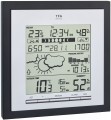—
Display backlight. The backlight feature enables reading the display in low light or darkness. Typically activated by pressing a button and deactivated upon release, this design minimizes energy consumption. However, some devices may keep the backlight on continuously for decorative purposes.
—
Clock. Clocks that show the current time vary in dial type and functionality based on the thermometer type mentioned earlier. Electronic models use digital displays with added features, while mechanical thermometers typically feature traditional arrow dials. Some of these mechanical models even resemble watches with an integrated thermometer, emphasizing the thermometer aspect rather than the clock.
—
Alarm clock. Possibility of giving a sound signal at a certain time set by the user. An alarm clock can be used not only for getting up in the morning, but also for any reminders associated with a specific time — for example, as an impromptu replacement for a kitchen timer. This feature, by definition, requires a clock (see above).
—
Calendar. The presence of a calendar implies at least the display of the current date on the thermometer (day of the month, often the month, less often the year). In addition, electronic models may provide viewing the year by month. The calendar can be used not only by itself, but also fo
...r other functions — for example, fixing min / max temperature moments (see above).
— Moon calendar. This function provides a display of the current phase of the moon, and in most cases also allows you to determine the days of new moons and full moons. Auspicious moments for many types of human activities (cosmetic procedures, treatment, gardening) are directly dependent on the phases of the moon. This feature assumes a regular calendar (see above).
— Synchronization with smartphone. The ability to remotely connect to the device using a mobile phone (tablet) allows you to remotely monitor weather conditions and read all information from sensors.
